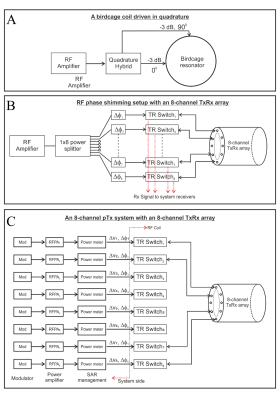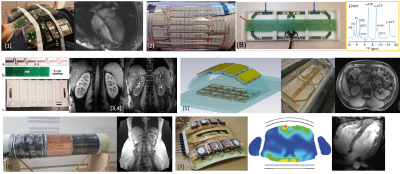Weekend Course
Multi-Channel Transmit: From Coil to Pulse Design
ISMRM & ISMRT Annual Meeting & Exhibition • 03-08 June 2023 • Toronto, ON, Canada

| 13:15 |
 |
Introduction: Parallel Transmit Concepts
Sydney Williams
Keywords: Physics & Engineering: Pulse design, Physics & Engineering: Hardware, Physics & Engineering: RF Safety This talk introduces parallel transmission (pTx) concepts that will be expanded upon in further speaker presentations during the session. The covered topics include a historical overview and motivation for pTx, multi-transmit radiofrequency (RF) coils, electromagnetic fields (EMFs) and specific absorption rate (SAR), mapping the transmit RF field, $$$B_{1}^{+}$$$, and static and dynamic pTx pulses. |
| 13:45 |
Multi-Channel Coil Design & Applications: Neuro
Irena Zivkovic
Keywords: Physics & Engineering: Hardware, Neuro: Brain, Physics & Engineering: High-Field MRI At clinical fields (1.5T and 3T), volume coils are usually used for excitation and multichannel local surface coils for receiving a signal. At higher fields, volume coils cannot produce homogeneous excitation due to intrinsically shorter wavelength in a tissue which causes constructive and distractive interference effects. For that reason, transmit only or transcieve (both transmit and receive) multichannel arrays are introduced. In those arrays, individual elements can be fed independently where magnitude/phase and RF waveforms can be optimized to produce desired B1+ field. In this talk, we will analyze different coil concepts used as array elements in brain imaging applications. |
|
| 14:15 |
 |
Multi-Channel Coil Design & Applications: Body
Alexander Raaijmakers
Keywords: Physics & Engineering: Hardware, Physics & Engineering: High-Field MRI, Physics & Engineering: Physics This lecture will focus at coil array development for body imaging at ultrahigh field strengths. Here, the standard clinical transmit coil (birdcage body coil) is not available. A wide range of various coil arrays for body imaging at ultrahigh fields have been developed for various applications. Next to presenting these developments and applications, this lecture will outline design criteria of transmit and receive arrays for body imaging in general. Various coil array concepts that were specifically designed for body imaging at ultrahigh field strengths will be explained in more detail. Finally, also X-nuclei coil array designs will be touched upon. |
| 14:45 |
Break & Meet the Teachers |
|
| 15:05 |
SAR & Validation
Thomas Fiedler
Keywords: Physics & Engineering: RF Safety The introduction of multi-channel parallel transmit (pTx) systems to mitigate RF inhomogeneities in UHF-MRI has significantly increased the safety management complexity and SAR prediction concepts has to be extended to satisfy the new requirements. In pTx systems, the resulting SAR distribution depends on the particular RF pulses (time-dependent amplitude and phase) used in the sequence. This lecture will focus on RF safety in pTx systems and give an overview of: RF monitoring techniques, SAR supervision using Q-matrices and VOPs, safety factors and validation techniques. |
|
| 15:35 | Pulse Design & Signal Control Xiaoping Wu | |
| 16:05 | Universal Pulses Vincent Gras | |
| 16:35 |
B1 Mapping
Martijn Cloos
Keywords: Physics & Engineering: Physics, Physics & Engineering: High-Field MRI, Image acquisition: MR Fingerprinting This talk reviews key principles used to map the transmit field ($$$ B_1^+$$$), in Magnetic Resonance Imaging (MRI). After a brief review of the physics that shapes the $$$ B_1^+$$$, we will spend most of our time developing a sense for the challenges associated with $$$ B_1^+$$$ mapping and briefly highlight how some of the more popular solutions in use today deal with these challenges. |
The International Society for Magnetic Resonance in Medicine is accredited by the Accreditation Council for Continuing Medical Education to provide continuing medical education for physicians.